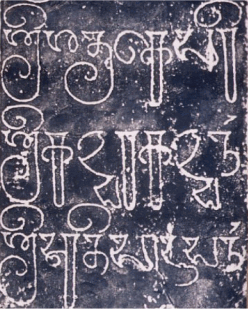Inscriptions in Grantha Script
Grantha is the name applied to the script used in Tamil Nadu for writing the Sanskrit language. The word Grantha denotes in Sanskrita literary work. Evidently the script used for writing the Sanskrit works obtained the same name. At one time it was prevalent throughout South India. When the Malayalam language began to freely borrow words as well as the rules of grammar from Sanskrit, this script was adopted for writing that language and was known as Arya Ezhuthu . Thus, a similar adoption for writing was also made in the Tulu speaking region.
Both Grantha and Tamil scripts appear alike in modern forms. The evolution of both scripts from Brahmi was also more or less similar.The development of Grantha script in Tamil Nadu may be divided into four periods.The archaic and ornamental, the transitional, the medieval and the modern. Archaic and ornamental variety is commonly known as Pallava Grantha. Mahendravarman's Tiruchirappalli rock cut cave and other cave temple inscriptions, Narasimhan's Mamallapuram, Kanchi Kailasanatha and Saluvankuppam temple inscriptions, Mutharaiyar's Senthalai inscriptions are examples of this variety.
The transitional variety of Grantha inscriptions roughly belong to three centuries between 650 CE and 950 CE. Later Pallava's (Nandivarman's Kasakudi, Udayendram plates etc.) and Pandyan Nedunjadaiyan's Anaimalai inscription are samples for this.
The medieval variety is from about 950 CE to 1250 CE. Inscriptions of imperial Cholas of Thanjavur are examples for this.
The modern variety belongs to later Pandya's and Vijayanagarar period. After the introduction of printing machines many Sanskrit books transcribed from palm leaves were printed in Grantha script. After Independence the popularity of Hindi in Deva Nagari script influenced all printing works and Grantha script went out of vogue.









